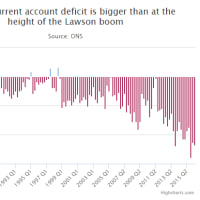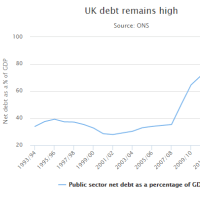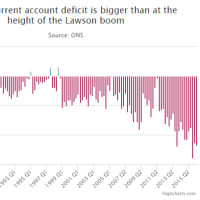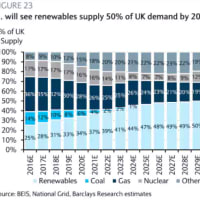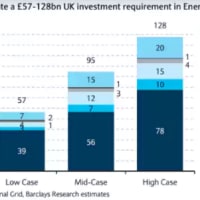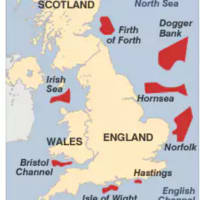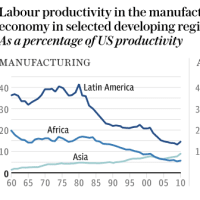HSBC fears world recession with no lifeboats left
(HSBCが救命ボートのない世界的不況を危惧)
By Ambrose Evans-Pritchard
Telegraph: 5:00PM BST 24 May 2015


(HSBCが救命ボートのない世界的不況を危惧)
By Ambrose Evans-Pritchard
Telegraph: 5:00PM BST 24 May 2015
The world authorities have run out of ammunition as rates remain stuck at zero. They have no margin for error as economy falters
金利がゼロに張り付いたままなので、世界中の中銀が弾切れになりました。景気が行き詰まってももう失敗の余地はありません。
The world economy is disturbingly close to stall speed. The United Nations has cut its global growth forecast for this year to 2.8pc, the latest of the multinational bodies to retreat.
世界経済は恐ろしいほど失速速度寸前です。
国連は今年度の世界の成長見通しを2.8%へと下方修正し、手を退いた直近の多国籍機関となりました。
We are not yet in the danger zone but this pace is only slightly above the 2.5pc rate that used to be regarded as a recession for the international system as a whole.
僕らは未だ危険地帯に入り込んでいませんが、このペースはかつて国際システム全体の不況とみなされたレベルの2.5%を僅かに上回るばかりです。
It leaves a thin safety buffer against any economic shock - most potently if China abandons its crawling dollar peg and resorts to 'beggar-thy-neighbour' policies, transmitting a further deflationary shock across the global economy.
経済ショックに対する安全バッファーは薄い…中国が身の毛もよだつ米国ドル・ペッグを放り出して「近隣窮乏」政策に乗り出し、世界中にデフレ・ショックを放つって可能性が一番高いかも。
The longer this soggy patch drags on, the greater the risk that the six-year old global recovery will sputter out. While expansions do not die of old age, they do become more vulnerable to all kinds of pathologies.
このうやむやな時間が続けば続くほど、始まって早6年になる世界的景気回復が逝くリスクは高まります。
景気回復は老衰しないものの、あらゆる種類の病気に弱くなるのは確かです。
A sweep of historic data by Warwick University found compelling evidence that economies are more likely to stall as they age, what is known as "positive duration dependence". The business cycle becomes stretched. Inventories build up and companies defer spending, tipping over at a certain point into a self-feeding downturn.
ウォリック大学がまとめた膨大な歴史的データからは、経済は時間が経つにつれ失速する(「正の期間依存性」)という圧倒的な証拠が見つかりました。
ビジネスサイクルは延びています。
在庫は増加し、企業は支出を削減し、いずれ自己推進的沈滞に陥るでしょう。
Stephen King from HSCB warns that the global authorities have alarmingly few tools to combat the next crunch, given that interest rates are already zero across most of the developed world, debts levels are at or near record highs, and there is little scope for fiscal stimulus.
HSBCのスティーヴン・キング氏は、先進国の大半が既にゼロ金利で債務レベルも記録更新な上に財政刺激の余地も殆どないことを思えば、世界中の中銀に次の危機に対応するためのツールはほとんどない、とワーニングします。
"The world economy is sailing across the ocean without any lifeboats to use in case of emergency," he said.
「世界経済は緊急時の救命ボートもなく大海を航海しているわけさ」
In a grim report - "The World Economy's Titanic Problem" - he says the US Federal Reserve has had to cut rates by over 500 basis points to right the ship in each of the recessions since the early 1970s. "That kind of traditional stimulus is now completely ruled out. Meanwhile, budget deficits are still uncomfortably large," he said.
気の滅入るレポート、『世界経済のタイタニック的問題』の中で同氏は、FRBは1970年代初頭から不況の度に体勢を立て直すために500BP以上も利下げせざるを得なくなったと記しています。
「その類の伝統的刺激は今や完全に外されたから。それと同時に、財政赤字は相変わらず気持ち悪いほど沢山ある」
The authorities are normally able to replenish their ammunition as recovery gathers steam. This time they are faced with a chronic low-growth malaise - partly due to a global 'savings glut', and increasingly to a slow ageing crisis across most of the Northern hemisphere. The Fed keeps having to defer its first rate rise as expectations fall short.
中銀は普通、景気回復が加速するにつれ弾を補充出来るものです。
今回は慢性的な低成長という問題に見舞われています(部分的原因は世界的な『過剰貯蓄』であり、北半球の殆どで起こりつつある高齢化危機の影響も徐々に大きくなっています)。
FRBは期待を裏切られているので、1回目の利上げを断念せざるを得ない状態が続いているわけです。
Each of the past four US recoveries has been weaker than the last one. The average growth rate has fallen from 4.5pc in the early 1980s to nearer 2pc this time. The US fiscal deficit has dropped to 2.8pc but is expected to climb again as pension and health care costs bite, even if the economy does well.
過去4回の米国の景気回復はいずれも前回よりも弱いものでした。
平均成長率は1980年代初頭は4.5%でしたが、今回は2%近くまで下回りました。
米国の財政赤字は2.8%まで減りましたが、年金と医療費が増えるにつれ、景気が良くても、再び上昇すると予想されています。
The US cannot easily launch a fresh New Deal. Public debt was just 38pc on GDP when Franklin Roosevelt took power in 1933, and there were few contingent liabilities hanging over future US finances.
米国が新たなニューディールをやるのは容易ではありません。
政府債務は、フランクリン・ルーズベルトが大統領に就任した1933年は僅か38%で、今後の米国の財政には引きずる負債は殆どありませんでした。
"Fiscal stimulus – a novel idea at the time – may have been controversial, but the chances of it working to boost economic activity were quite high given the healthy starting position. Today, it is much more difficult to make the same argument," he said.
「財政刺激策(当時は新発想)ってのはどうよって感じだったかもしれないけど、経済活動を活性化させてくれる確率は、そもそも健全財政だったことを思えば、結構高かったんだよね。今、同じ主張をしようと思ったら相当難しいよ」とのこと。
The great hope - and most likely outcome - is that the recent monetary expansion in the US and the eurozone starts to gain traction later this year. Broad 'M3' money data - a one-year advance indicator - has been growing briskly on both sides of the Atlantic. But nobody knows for sure whether the normal monetary mechanisms are working.
大きな期待(でもって一番あり得る結果)は、米国とユーロ圏の最近の金融緩和が今年中に勢いを付け始めるってことです。
広義の「M3」のデータ(1年先行)は大西洋の両岸でさくさくと伸びています。
でも、通常のマネタリー・メカニズムが動いているのかどうか、誰も確信が持てません。
JP Morgan estimates that the US economy contracted at an rate of 1.1pc in the first quarter, far worse than originally supposed.
JPモルガンの試算だと、米経済は第1四半期に-1.1%という当初の想定を遥かに下回るマイナス成長になったとか。
The instant tracking indicator of the Atlanta Fed – GDPnow – shows little sign that America is shaking off its mystery virus. Growth was just 0.7pc (annualised) in mid-May. It is becoming harder to argue the relapse is a winter blip or caused by temporary gridlock at California ports.
アトランタ連銀のGDPnowからは、米国が怪しいウイルスを振り切った様子は殆ど見てとれません。
5月中旬の成長率はたったの0.7%(年率)でした。
また悪くなっちゃったのは厳冬のせいだの、カリフォルニアの港が一時的停滞のせいだのという理屈はどんどん通らなくなってますね。
Over 100,000 lay-offs across the oil and gas belt seem to have taken their toll. The Fed thought the windfall gain of cheaper energy for everybody else would weigh more in the balance, but this time Americans have chosen to salt away the money.
石油ガス地帯での10万人を超える人員削減が影響してます。
FRBは、エネルギー安の非石油ガス業界人全員にとっての棚ボタ利益の方が重要だと思ってたみたいですが、今回、米国人はお金を貯めておくことにしたわけです。
Net saving jumped by $125bn to $728bn in the first quarter. There was no pick-up in April. Retail sales were flat.
純貯蓄残高は第1四半期に1,250億ドルから7,280億ドルまで急増しました。
4月に上昇は一切見られませんでした。
小売売上は横ばいです。
It is now more likely than not that US economy has dropped through the Fed's stall-speed threshold of two consecutive quarters below 2pc growth. Exactly how far below is unclear. The Fed uses its own growth measure - gross domestic income (GDI) - and this data has not yet been published.
米経済が2期連続2%以下というFRBの失速速度の閾値を突き抜けちゃった可能性は今やもっと高くなってますね。
底が奈辺にあるのかは謎です。
FRBは独自の成長尺度を使っていまして(GDI)、このデータはまだ公表されていません。
The stall speed concept is soft science but not to be ignored. "Output tends to transition to a slow-growth phase at the end of expansions," said a Fed research paper.
失速速度というコンセプトはソフトサイエンスですが、無視は出来ません。
「生産は景気拡大の終わりに低成長フェーズに移行する傾向がある」とFRBのリサーチペーパーには書かれています。
Much now depends on China, where the economy is starting to look "Japanese". Dario Perkins from Lombard Street Research says the Chinese economy is in a much deeper downturn than admitted so far by the authorities. It probably contracted outright in the first quarter.
今や多くのものが、経済が「日本的」に見え始めている中国にかかっています。
ロンバード・ストリート・リサーチのダリオ・パーキンス氏は、中国経済はこれまでに公式に認められているよりも遥かに深刻な沈滞にあると言ってます。
多分、第1四半期は完全に縮小したんじゃないでしょうか。
Electricity use has turned negative. Rail freight has been falling at near double-digit rates. What began as a deliberate move by Beijing to choke off a credit bubble has taken on a life of its own, evolving into a primordial balance-sheet purge.
電力使用量はマイナスに転じました。
鉄道輸送も二桁近いペースで落ち込んでます。
中国政府による意図的な信用バブル潰しとして始まったものは独り歩きして、原始的バランスシート・パージに進化したんですな。
It was inevitable that China's investment bubble would lead to vast inventory of unsold property. The country produced more cement between 2011 and 2013 than the US in the 20th Century -
中国の投資バブルがエベレストのような在庫物件の山になるのも仕方ないですね。
この国は2011-2013年の間に、20世紀の米国よりももっと沢山のセメントを生産しています。
Mr Perkins said China is now in a "classic debt deflation spiral" as excess capacity holds down prices. Factory gate inflation is now minus 4.6pc. This in turn is tightening the noose further by pushing up real borrowing costs.
パーキンス氏曰く、中国は今や過剰生産性が価格を押し下げる「古典的債務デフレ・スパイラル」に陥っているそうです。
工場出荷価格の上昇率はもう-4.6%です。
で、これが実質借入コストを押し上げて更に首を絞め上げています。
The Chinese authorities have so far resisted the temptation to flood the system with fresh stimulus, fearing that this would store up even greater trouble.
中国当局はこれまでのところシステムに追加刺激をぶちまける誘惑に抵抗していますが、こんなことしたら益々酷いトラブルを蓄積することになると恐れてるんですね。
They have taken steps to offset a clampdown on local government spending and avert a "fiscal cliff" that might otherwise have occurred. They have loosened policy for banks just enough to offset the contractionary effects of capital flight. But they have not yet come to the rescue.
地方自治体の支出抑制をオフセットして、さもなければ落っこちていたかもしれない「財政の崖」を回避するための対策を採りました。
資本逃避による緊縮効果をオフセットするに十分なだけ、銀行向けの政策を緩和しました。
でも、救援には駆けつけていません。
This matters enormously. Andrew Roberts from RBS says China accounted for 85pc of all global growth in 2012, 54pc in 2013, and 30pc in 2014. This is likely to fall to 24pc this year. "If there is only one statistic that you need to know in the world right now, this is it," he said.
これは恐ろしく重要です。
RBSのアンドリュー・ロバーツ氏は、中国は2012年の世界経済成長の85%を占めていたし、2013年は54%、2014年は30%を占めたと言ってます。
今年は24%になりそうですね。
「今、世界で知る必要のあるデータが一つだけあるとしたら、これだね」とのこと。
The effects are being felt across Asia. Japan keeps disappointing. Its exports to China have fallen 15pc over the last year. Korea is flirting with recession.
この効果は全アジアで感じられます。
日本にはガッカリさせられっぱなしです。
対中輸出は去年1年間で15%も減りましたから。
韓国は不況すれすれです。
Russia, Brazil, Argentina, and Venezuela are all contracting sharply, casualties of the China-driven commodity bust. The UN says the growth rate for the emerging market nexus (ex-China) has dropped to 2.3pc from an average of 6.5pc in the glory years of 2004-2007.
ロシア、ブラジル、アルゼンチン、ベネズエラ、いずれも急激に縮小してますが、中国主導のコモディティ・バストの被害者ですね。
国連曰く、新興市場軍団(除く中国)の成長率は2004-2007年の絶好調時代の平均6.5%から2.3%まで落ち込んだそうです。
Europe is doing better but it is hardly a boom. The eurozone is contributing little to global demand. The region has displaced China and to become the world's "saver of last resort" - or its biggest black hole in the view of critics - exploiting the weaker euro to rack up a current account surplus of $358bn.
ヨーロッパの方がマシですが、とても好景気とは言えません。
ユーロ圏は世界の需要に殆ど貢献してないし。
この地域は中国に取って代わって、ユーロ安を利用して3,580億ドルもの経常黒字を積み上げ、世界「最後の貯蓄家」になりました(というか、批判的に見れば最大のブラックホール)。
It is far from clear whether Europe can act as an engine of world recovery. The composite purchasing managers index (PMI) for services and manufacturing slipped in May, and new orders fell. Oxford Economics thinks the "sugar rush" from quantitative easing may be wearing off.
ヨーロッパが世界経済回復のエンジンになれるかどうか、さっぱりわかりません。
5月のサービス・製造業の総合PMIは下がりましたし、新規受注も減りました。
オックスフォード・エコノミクスは、QEの「シュガーラッシュ」も薄れつつあるのかもしれないと考えています。
HSBC's Mr King says the global authorities face awful choices if the world economy hits the reefs in its current condition. The last resort may have to be "helicopter money", a radically different form of QE that injects money directly into the veins of economy by funding government spending.
HSBCのキング氏曰く、各国当局は世界経済が今の状態で暗礁に乗り上げた場合、恐ろしい選択を迫られるとか。
最後の望みは「ヘリコプターで現金ばらまき」、政府支出を賄ってマネーを経済に直接注入するという全く形の違うQEでなければならないのかもしれません。
It is a Rubicon that no central bank wishes to cross, though the Bank of Japan is already in up to the knees.
これはどの中銀も渉りたくないルビコン川ですが、日銀は既に川にどっぷりです。
The imperative is to avoid any premature tightening or policy error that could crystallize the danger. As Mr King puts it acidly. "Many – including the owner of the Titanic – thought it was unsinkable: its designer, however, was quick to point out that 'She is made of iron, sir, I assure you she can'."
時期尚早な引き締めや危険を現実化しかねない政策ミスを回避することが欠かせません。
キング氏が辛辣に言う通りなのです。
「オーナーを含む沢山の人間が、タイタニックは絶対沈まないと思ってたのさ。でも、設計者は直ぐに指摘したんだよ。『僭越ではございますが、タイタニック号は鉄で出来ておりますので、確実に沈みます』って」




















